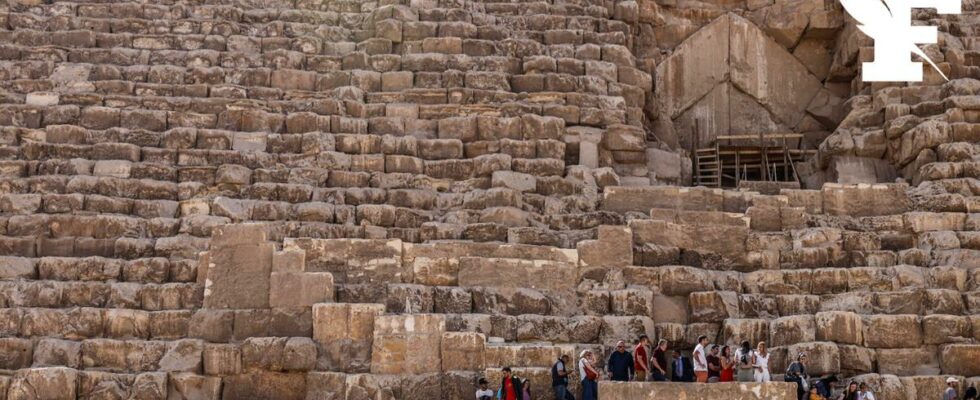ARCHEOLOGY – The ScanPyramids mission filmed in February the mysterious corridor it had identified in 2016, above the main entrance.
There is something new behind the thick, four thousand year old blocks of the tomb of King Cheops. Seven years after having discovered the existence of unknown cavities hidden in the depths of the largest of the pyramids of Giza, facing Cairo, the scientists of the international ScanPyramids project deliver a first glimpse of one of these so much fantasized spaces. Located behind the entrance to the north face of the monument, the corridor in question concealed nothing unexpected. Bare walls. No mummy in ambush or unsuspected treasures. It is nonetheless fabulous in the eyes of specialists.
This space of two meters wide, under rafters, stretches over nearly nine meters. It could be inspected on February 24 thanks to a tiny opening detected by radar in the joint of the entrance rafters. Failing to pass a head there, the researchers used a tiny camera, an endoscope with a diameter of five millimeters, passed through a copper pipe, to obtain an overview of this space hidden since the construction of the monument.
Read alsoRoyal Palace and Great Temple of Sumerian City of Girsu Uncovered
Of what use was this blind corridor, laid out at the northern end of the immense tomb of Cheops? If the track of a landfill space supposed to distribute the mass above the main entrance of the pyramid is advanced by the Egyptian authorities, the scientists of the ScanPyramids project, they are careful not to decide. Their interest lies elsewhere: the now proven existence of this space proves what their instruments had detected in 2016, thanks to the principle of muon radiography. “These images confirm the presence of this cavity which we already suspected existed at 99.99%. They also complete the proof of the effectiveness of our non-destructive and non-invasive methods”underlines Mehdi Tayoubi, co-director of the ScanPyramids mission.
Interior view of the cavity discovered in 2016, inside the Great Pyramid of Giza. ScanPyramids
Adapted to the context of the pyramid by the University of Nagoya and the Commissariat for Atomic Energy and Alternative Energies (CEA), muography consists of capturing elementary particles sensitive to the bodies they pass through. This technique has made it possible to identify since 2016 two hitherto unknown spaces inside the Great Pyramid: the North Face Corridor (NFC), located near the entrance, as well as a “large void” ( nicknamed SP-BV), at least forty meters long and which would be about ten meters above the large gallery.
View of the north facade of the Cheops pyramid, at the foot of the monument, in November 2022. The corridor inspected by the ScanPyramids mission is located above the rafters of the main entrance, which today serves as access for tourists . Amir MAKAR, AFP
The last riddles of the pyramid
According to the images of the endoscope, the corridor inspected does not appear to be connected to the “great void”. “A smaller corridor, less than one meter, between these two structures cannot be completely ruled out from these measurements”note however the 36 researchers associated with the ScanPyramids mission in an article published Thursday in the scientific journal NatureCommunications . The track of a corridor which would have been filled is not to be ruled out either, notes Mehdi Tayoubi. The charismatic Egyptian archaeological Zahi Hawass already dreams of finding “the real burial chamber of King Cheops”. The work, decidedly, is not about to be completed. “We will continue our scan campaign”, confirmed Thursday the head of the Supreme Council of Antiquities, Mostafa Waziri, at the foot of the pyramids.
Read alsoA missing arm of the Nile enabled the construction of the Giza pyramids
Launched in 2015 under the aegis of the Egyptian Ministry of National Antiquities, the ScanPyramids scientific mission associates Cairo University with the French Institute HIP. Supported by Dassault Systèmes, the association coordinates the range of actors involved in the project and managed, on the Egyptian side, by a scientific committee headed by Zahi Hawass. Among the latest partners in the adventure, the Technical University of Munich conducted additional radar examinations on the north face of the pyramid, between 2020 and 2022, to refine the contours of the cavity.
Zahi Hawass, Egyptian archaeologist and former minister of antiquities, in front of the Great Sphinx of Giza, in Giza, Egypt, November 20, 2019. Khaled DESOUKI / AFP
Eventually, the identification and study of these new spaces of the Great Pyramid could make it possible to better understand the last enigmas of its construction. Several competing hypotheses exist on this architectural problem, which could have been solved by external or internal ramp systems, or even by a mixture of the two. The monument built around 2560 BC, during the time of the Egyptian Old Kingdom, remained for several millennia the tallest human structure ever built. And the unsolved mysteries of this wonder of the world still do not fail to fascinate.
SEE ALSO – Peru: 600-800-year-old mummy found in ex-delivery man’s cooler bag
